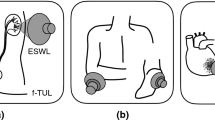Abstract
Extensive studies on laser lithotripsy of urinary and gall calculi using a microsecond pulsed dye laser have yielded information on the mechanism of plasma initiation, expansion and shock wave fragmentation relevant to the determination of optimum fragmentation conditions. The key to plasma formation lies in the initial absorption of laser energy by the calculus surface to produce a sufficient density of localized vapour to absorb strongly laser energy. The subsequent ionization of the vapour by the further absorption of laser energy leads to plasma formation. The absorbance of several calculi pigmentations have been measured giving an indication of the individual susceptibility to laser induced breakdown. The plasma threshold is measured to be fluence dependence, which is caused by the vaporization and the further heating of the vapour. The transient expansion of the plasma imparts an impulse on stone and induces a sharp shock wave with peak pressure as high as 10 kilobar leading to the fragmentation of calculi.
Similar content being viewed by others
References
Watson GM. A survey of the action of lasers on stones. In: Steiner R (ed)Laser lithotripsy. London: Springer-Verlag, 1988:15
Nishioka NS, Anderson RR. Fragmentation of biliary calculi with tunable dye lasers.Gastrointest Endosc 1986,32:157–60
Whitehurst C, King TA. Internal Report ML3: Stone identification and fragmentation via laser lithotripsy using a flashlamp-pumped dye laser. Wolfson Laser and Fibre Optics Unit, Physics Department, Manchester University, UK, 1989
Teng P, Nishioka NS, Anderson RR, Deutsch TF. Optical studies of pulsed-laser fragmentation of biliary calculi.Appl Phys B 1987,42:73–8
Teng P, Nishioka NS, Anderson RR, Deutsch TF. Acoustic studies of the role of immersion in plasmamediated laser ablation.IEEE J Quant Elect 1987,QE-23:1845–52
Jiang ZX, Whitehurst C, King TA, Holden D. Basic mechanisms in laser lithotripsy. 2: spectroscopic analysis.Lasers Med Sci 1991 (in press)
Meyer W, Engelhardt R, Hering P. Laser induced breakdown spectroscopy of kidney stones. In: Steiner R (ed)Laser lithotripsy. London: Springer-Verlag, 1988:25
Helfmann J, Berlin HP, Brodzinski T et al. Identification of body concrements by fast time-resolved spectroscopy of laser induced plasma. In: Steiner R (ed)Laser lithotripsy. London: Springer-Verlag, 1988:31
Ready JF.Effects of high-power laser radiation. New York: Academic Press, 1971:Chaps 3–5
Bekefi G.Principles of laser plasma. New York: Wiley, 1976:Chap. 13
Kroll N, Watson KM. Theoretical study of ionization of air by intense laser pulses.Phys Rev A 1972,5:1883–905
Wright JK. Theory of the electrical breakdown of gases by intense pulses of light.Proc Phys Soc 1964,84:41–6
Zel'dovich YB, Raizer YP. Cascade ionization of a gas by a light pulse.Sov Phys JETP 1965,20:772–80
Keldysh LV. Ionization in the field of a strong electromagnetic wave.Sov Phys JETP 1965,20:1307–14
Gould L, Roberts LW. Breakdown of air at microwave frequency.J Appl Phys 1956,27:1162–70
Beckman P, Spizzichino A.The scattering of electromagnetic waves from a rough surface. Oxford: Pergamon Press, 1963:Chaps 1–3 (Vol. 4 in Fork VA, Wait JR (eds)International Series of Monographs on Electromagnetic Waves)
Jiang ZX, Zhang YW. Measurements of emittance, reflectance, transmittance and temperature of a semitransparent body.Chinese J Infra Res 1989,8:49–56
Zhang YW, Jiang ZX. Equivalent blackbody radiation theory and its use in the radiation property measurements of a semi-transparent body.Appl Opt 1989,28:4482–86
Bell CE, Landt JA. Laser-induced high-pressure shock waves in water.Appl Phys Lett 1967,10:46–8
Coleman AJ, Saunders JE, Preston RC, Bacon DR. Pressure waveforms generated by a Dornier Extracorporeal shock-wave Lithotripter.Ultrasound Med Biol 1987,13:651–7
Hofmann R, Hartung R, Geissdörfer K et al. Laser induced shock wave lithotripsy-biologic effects of nanosecond pulses.J Urol 1988,139:1077–9
Jiang ZX, Whitehurst C, King TA. Internal Report Litho-3: Measurement of the absorbance of calculi with optical fibres. Wolfson Laser and Fibre Optics Unit, Physics Department, Manchester University, UK, 1989
Author information
Authors and Affiliations
Rights and permissions
About this article
Cite this article
Jiang, Z.X., Whitehurst, C. & King, T.A. Basic mechanisms in laser lithotripsy. 1: Optoacoustic-mechanical analysis. Laser Med Sci 6, 443–450 (1991). https://doi.org/10.1007/BF02042468
Received:
Issue Date:
DOI: https://doi.org/10.1007/BF02042468




